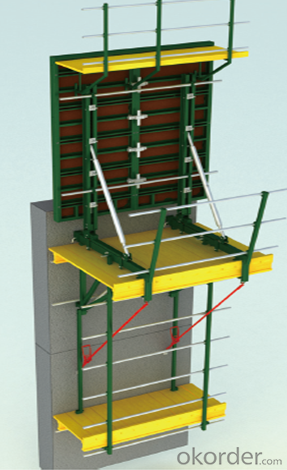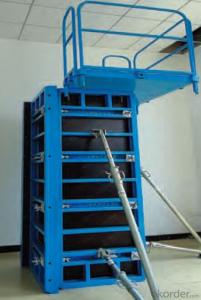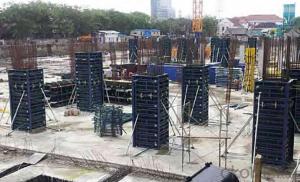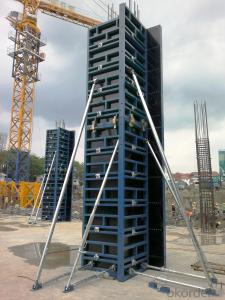Steel Frame Formwork of Convenient and Fast Operation
- Loading Port:
- Shanghai
- Payment Terms:
- TT OR LC
- Min Order Qty:
- 1 m²
- Supply Capability:
- 100000000 m²/month
OKorder Service Pledge
OKorder Financial Service
You Might Also Like
1. Structure of Steel Frame Formwork GK120
There is a prizing part designed in the corner, which can help to position and remove formwork easily.
The plywood is screwed on from the back when connecting frame and plywood, so the surface of the finished concrete is perfect.
The formwork series are a complete system with a full set of accessories, and can be set up flexibly according to project demand.
2. Main Features of Steel Frame Formwork GK120
Light weight
High strength
High standardized system
Easy connection with adjustable steel clamp
Convenient and fast corner formwork
Flexible to assemble and application
3. Steel Frame Formwork GK120 Images

4. Steel Frame Formwork GK120 Specification
-The steel frame formwork is plywood covered with hollow steel. The plywood is 18 mm thick.
-The frame is highly strengthened, and the wall formwork can bear lateral pressure 60 KN/m2 while the column formwork can bear 80 KN/m2.
-As a standardized system, it is flexible to assemble , wood batten can be filled to satisfy the need f of non-standard size.
-The adjustable steel clamp is convenient to use, and can hold tightly.
-There is a prizing part designed in the corner, which can help to position and remove formwork easily.
-The plywood is screwed on from the back when connecting frame and plywood, so the surface of the finished concrete is perfect.
-The formwork series are a complete system with a full set of accessories, and can be set up flexibly according to project demand.
5. FAQ of Steel Frame Formwork GK120
1) What can we do for you?
.We can ensure the quality of the vinyl banner and avoid extra expenses for customers.
.We can provide you the professional design team.
.We can provide fashionable and newest styles for you.
.We can design the artwork for you.
. Please feel free to customize.
2) What promises can be done by us?
. If interested in Steel Frame Formwork GK120, please feel free to write us for any QUOTE.
. If printing required, please advise asap because the whole set need much more time to complete.
. Please DO check goods when courier knocks your door and contact us asap if any issue.
3) What about of our after-sale service?
. Response will be carried out in 24hours after receiving any complain or request.
. Steel Frame Formwork GK120 cost can be refund after order is confirmed.
. If the products are not based on the requirements, there will be the relevant compensations made for you.
4) What about the package and shipping time?
.Packing: As Customer's Requirements
.Shipping: We have various shipping ways for our customers, such as express which including TNT, DHL, FEDEX, UPS, EMS, etc. ; by air/ sea, and we are VIP of these express.
.Shipping time:
Normally small orders, it just 10-15 business days to arrive your hand; When comes to the customs declaration, it may need 7 days.
Other mass qty of Steel Frame Formwork GK120, we send them out by sea or by air to sea port or air port to save some shipping freight for our customers. By ocean, it may need 45~60days, by air, it may need 25~40days.
- Q:How does steel frame formwork affect the overall insulation of a structure?
- Steel frame formwork does not directly affect the overall insulation of a structure as it is primarily used as a temporary support system during construction. Insulation is typically added separately to the walls, roof, and floors of a structure to provide thermal resistance and maintain desired temperature levels.
- Q:What are the different surface treatments available for steel frame formwork?
- Some of the different surface treatments available for steel frame formwork include galvanization, painting, powder coating, and epoxy coating.
- Q:How does steel frame formwork handle different types of concrete surface protection methods?
- Steel frame formwork proves to be a versatile and long-lasting system capable of accommodating a variety of concrete surface protection techniques. The primary objective of safeguarding the concrete surface is to enhance both its durability and visual appeal. Numerous methods exist for ensuring this protection, including the use of surface coatings, membranes, and form liners. By utilizing steel frame formwork, a reliable and stable structure is provided for the implementation of these protective methods. Consisting of steel frames and panels specifically engineered to withstand the pressure exerted by fresh concrete during pouring and curing, this robust structure guarantees the even and effective application of concrete surface protection techniques. The utilization of steel frame formwork facilitates the easy application of surface coatings such as sealers and paints to the concrete surface. The smooth and level surface offered by the formwork system enables the straightforward application of these coatings, ensuring a uniform and consistent finish. Additionally, the steel frames provide a sturdy support system for workers, granting them access to the entirety of the surface and ensuring the thorough and accurate application of coatings. Steel frame formwork also allows for the installation of membranes such as waterproofing and vapor barriers. The formwork system's precision enables precise positioning and attachment of these membranes, guaranteeing comprehensive coverage of the concrete surface and effective protection against moisture and other external factors. The steel frames provide a robust foundation for the membranes, securing them firmly in place throughout the concrete pouring and curing processes. Moreover, steel frame formwork readily accommodates the incorporation of form liners, which are employed to create decorative patterns and textures on the concrete surface. The form liners can be affixed to the steel panels, enabling the creation of unique and visually appealing designs. The rigid structure of the steel frames ensures that the form liners remain securely in place during pouring and curing, resulting in precise and consistent patterns. To conclude, steel frame formwork is highly suitable for a diverse range of concrete surface protection methods. Its sturdy and durable structure enables the effective implementation of surface coatings, membranes, and form liners, ultimately yielding a safeguarded and aesthetically pleasing finished concrete surface.
- Q:Can steel frame formwork be reused multiple times?
- Yes, steel frame formwork can be reused multiple times. Unlike traditional timber formwork, steel frame formwork is designed to be durable and long-lasting. It is made of high-quality steel, which ensures its strength and stability, making it suitable for multiple uses. Steel frame formwork can withstand the pressure and weight of concrete and can be easily cleaned and maintained after each use. This reusability makes steel frame formwork a cost-effective and environmentally friendly option for construction projects.
- Q:What are the different types of formwork pins used with steel frame formwork systems?
- Formwork pins are essential components in steel frame formwork systems, serving to secure formwork panels and ensure stability while pouring concrete. Here are several types of formwork pins commonly utilized: 1. Wedge pins: The most widespread formwork pins, they possess a steel composition with a wedge-shaped end. By inserting the wedge into the formwork panel slot and using a hammer, the pin is driven into place. This wedging action tightly secures the formwork panels, effectively preventing movement during concrete pouring. 2. Straight pins: Similar to wedge pins, straight pins are also made of steel, but with a cylindrical shape. These pins are inserted into pre-drilled holes in the formwork panels and secured using a hammer. Straight pins are suitable when wedge pins cannot be easily inserted or when additional reinforcement is required. 3. Snap ties: This formwork pin type consists of a metal rod with a button-like head. The rod is inserted through the formwork panels, and the head is snapped into place, firmly securing the panels together. Snap ties are commonly employed in formwork systems that necessitate quick assembly and disassembly. 4. Coil ties: Coil ties serve as another formwork pin option for connecting formwork panels. They feature a metal rod with a spiral coil at one end. The coil is inserted into pre-drilled holes in the formwork panels, and the rod is twisted to tightly secure the panels. Coil ties provide a robust and secure connection between the formwork panels. 5. Flat ties: Utilized specifically in wall formwork systems, flat ties secure formwork panels in a flat orientation. These pins consist of a metal rod with a flat plate-like head. By inserting the rod through the formwork panels and twisting the head, the panels are securely fastened together. In summary, the diverse range of formwork pins employed in steel frame formwork systems offers various options to ensure secure and stable connections between formwork panels during concrete pouring.
- Q:What are the different types of formwork pins used in steel frame formwork systems?
- There are several different types of formwork pins that are commonly used in steel frame formwork systems. These pins are essential for securing the formwork panels and ensuring the stability of the entire structure. Some of the different types of formwork pins used in steel frame formwork systems include: 1. Wedge pins: These are the most commonly used formwork pins and are designed to secure the formwork panels together. They have a wedge shape that allows them to be easily inserted and removed. Wedge pins are typically made of steel and are available in various sizes to accommodate different thicknesses of formwork panels. 2. Flathead pins: These pins have a flat head and are used to hold the formwork panels in place. They are inserted through holes in the formwork panels and secured with a nut or washer on the opposite side. Flathead pins provide a secure connection and are often used in combination with other types of pins for added stability. 3. Connecting pins: These pins are used to connect two or more formwork panels together. They typically have a threaded end that allows them to be screwed into the panels. Connecting pins are commonly used in situations where a tight and secure connection is required, such as when forming corners or curved walls. 4. Tapered pins: These pins have a tapered shape, with one end being larger than the other. They are used to align and secure formwork panels by inserting the larger end into pre-drilled holes in the panels. Tapered pins provide a tight fit and are often used in conjunction with other types of pins for added stability. 5. Snap pins: These pins have a snap-on design that allows them to be easily attached and detached from the formwork panels. They are typically made of plastic or metal and are used in situations where frequent assembly and disassembly of the formwork is required. Overall, the different types of formwork pins used in steel frame formwork systems serve the purpose of securing the formwork panels and ensuring the stability of the entire structure. The specific type of pin used will depend on factors such as the formwork system being used, the thickness of the panels, and the desired level of stability and security.
- Q:Can steel frame formwork be used for the construction of educational facilities?
- Yes, steel frame formwork can be used for the construction of educational facilities. Steel formwork is durable, strong, and provides excellent structural support. It is commonly used in construction projects, including educational facilities, due to its ability to withstand heavy loads and provide a secure framework for concrete pouring. Additionally, steel formwork is reusable, which makes it a cost-effective and sustainable choice for construction projects.
- Q:How does steel frame formwork handle different types of formwork stripping equipment?
- Steel frame formwork is a versatile and durable system that can handle different types of formwork stripping equipment with ease. The steel frames, which are designed to provide stability and support, can accommodate various stripping tools such as mechanical or hydraulic systems. One of the advantages of steel frame formwork is its ability to withstand the high pressure and force exerted during the stripping process. This is crucial when different types of stripping equipment are used, as they require a strong and sturdy support system to ensure safe and efficient formwork removal. The steel frames are engineered to provide a stable and secure platform for the stripping equipment. They are designed with precision and accuracy to ensure proper alignment and compatibility with different types of stripping tools. This ensures that the stripping equipment can be securely attached to the steel frame formwork, allowing for effective and efficient formwork removal. Furthermore, steel frame formwork is highly adaptable, making it suitable for use with various types of formwork stripping equipment. Whether it is a mechanical stripping system that relies on mechanical force or a hydraulic system that utilizes hydraulic power, the steel frames can accommodate and work seamlessly with these different types of equipment. In conclusion, steel frame formwork is specifically designed to handle different types of formwork stripping equipment. Its strength, stability, and adaptability make it an ideal choice for construction projects that require efficient and safe formwork removal.
- Q:How is steel frame formwork secured in place?
- Steel frame formwork is secured in place using various methods. One common method is through the use of steel rods or tie-rods. These rods are inserted through holes in the formwork panels and are then anchored to the ground or to existing structures using various anchoring systems such as anchor plates, anchor nuts, or anchor bolts. Additionally, adjustable braces or struts are often used to provide additional support and stability to the steel frame formwork. These braces are connected to the formwork panels and are adjusted to the desired position and angle to ensure proper alignment and stability. Furthermore, in some cases, the steel frame formwork may be temporarily attached or clamped to existing structures or columns to provide additional stability during the construction process. This can be done using clamps, brackets, or other similar attachment methods. Overall, the primary goal of securing steel frame formwork in place is to ensure stability, alignment, and structural integrity during the concrete pouring and curing process. This is crucial to achieve high-quality and accurate construction results.
- Q:How does steel frame formwork handle different types of concrete curing temperatures?
- Steel frame formwork is highly versatile and capable of handling different types of concrete curing temperatures. The steel frame provides excellent strength and stability, allowing it to withstand both high and low curing temperatures without warping or distorting. Additionally, the steel material has good thermal conductivity, which helps in efficiently distributing heat during curing. This ensures that the concrete cures evenly and achieves optimal strength and durability regardless of the curing temperature.
1. Manufacturer Overview |
|
|---|---|
| Location | |
| Year Established | |
| Annual Output Value | |
| Main Markets | |
| Company Certifications | |
2. Manufacturer Certificates |
|
|---|---|
| a) Certification Name | |
| Range | |
| Reference | |
| Validity Period | |
3. Manufacturer Capability |
|
|---|---|
| a)Trade Capacity | |
| Nearest Port | |
| Export Percentage | |
| No.of Employees in Trade Department | |
| Language Spoken: | |
| b)Factory Information | |
| Factory Size: | |
| No. of Production Lines | |
| Contract Manufacturing | |
| Product Price Range | |
Send your message to us
Steel Frame Formwork of Convenient and Fast Operation
- Loading Port:
- Shanghai
- Payment Terms:
- TT OR LC
- Min Order Qty:
- 1 m²
- Supply Capability:
- 100000000 m²/month
OKorder Service Pledge
OKorder Financial Service
Similar products
New products
Hot products




























